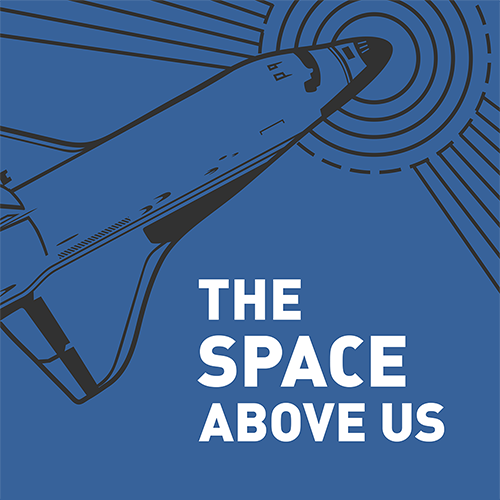Episode 138: STS-64 - Ghostbusters and Angry Russians (LITE, SPARTAN, SAFER)
Table of Contents
Space Shuttle Discovery is all loaded up with a grab bag of shuttle program favorites. Rendezvous, tech demonstrations, even an untethered EVA! Just be careful for the ghosts in the bathroom..
Episode Audio #
Photos #
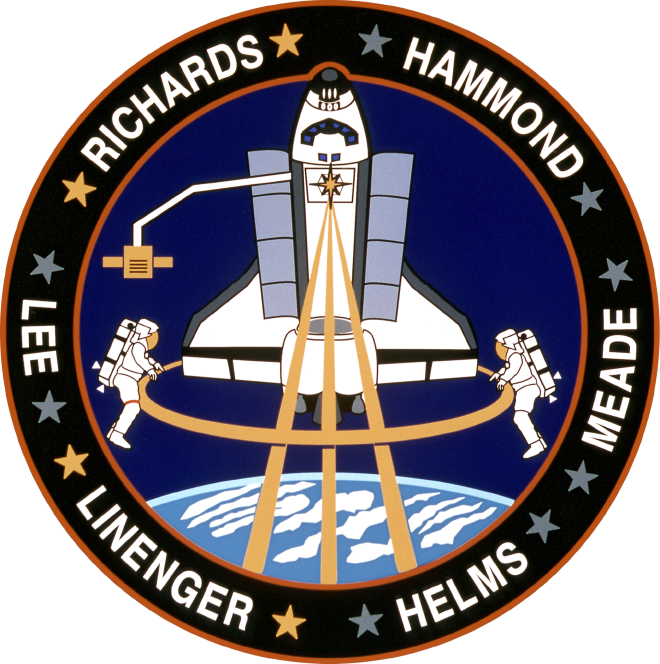
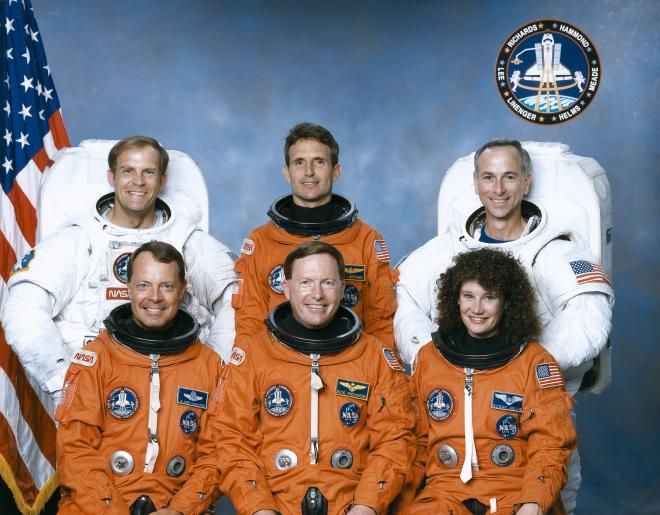
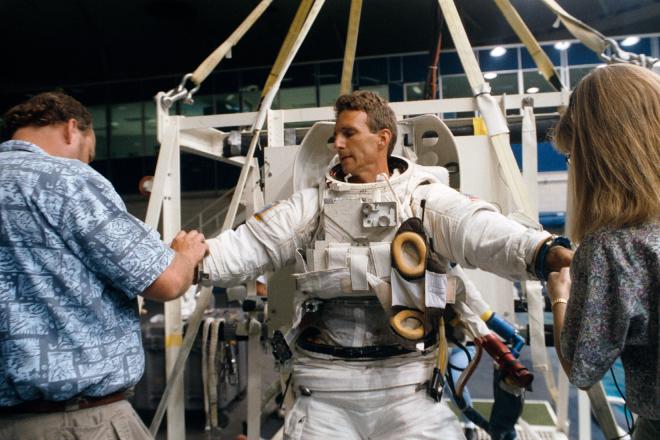
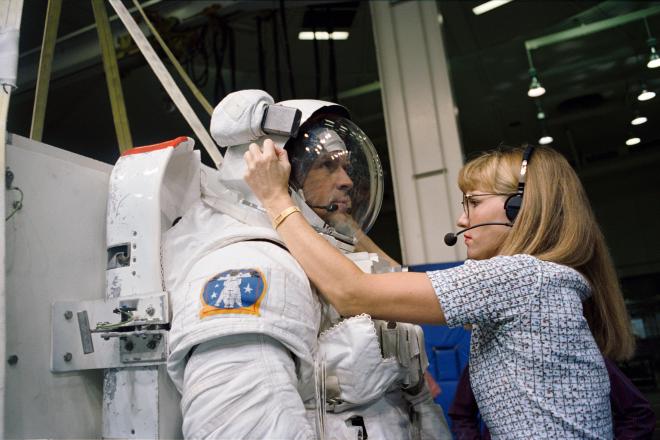
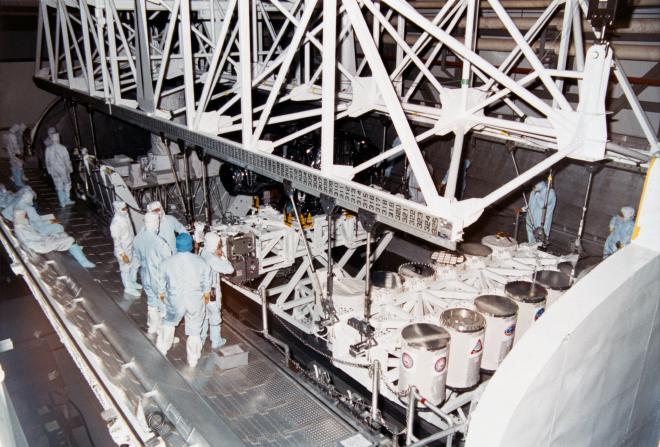
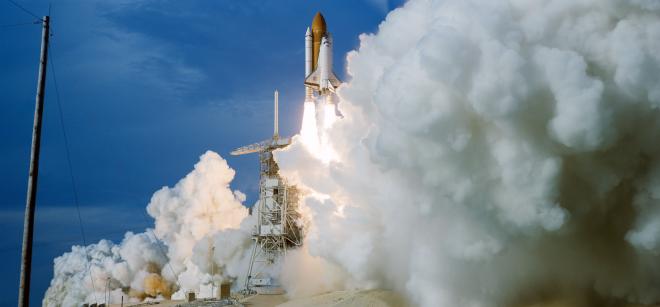
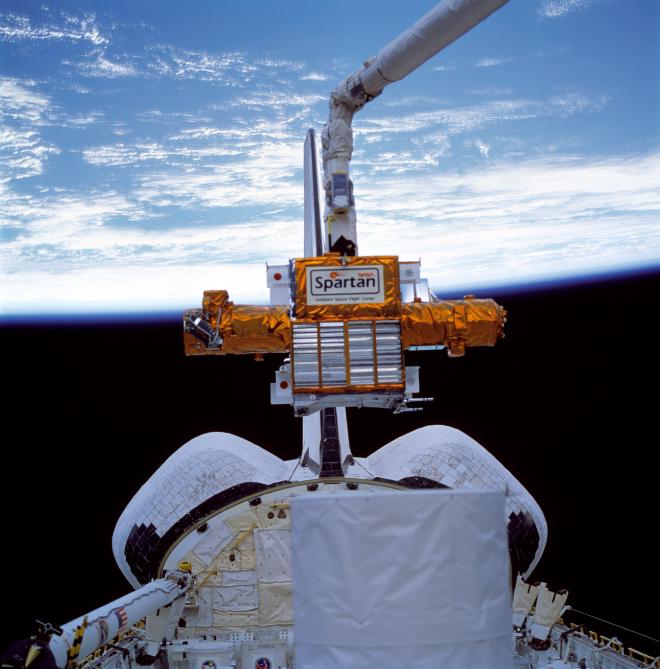
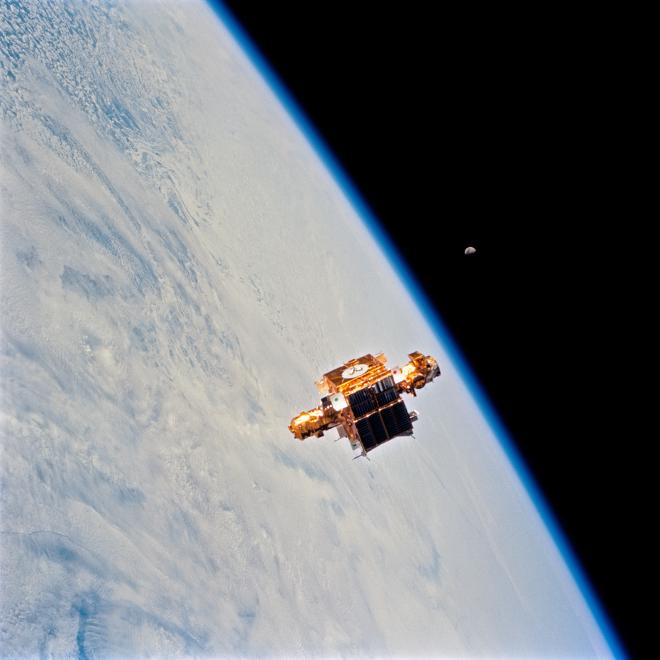
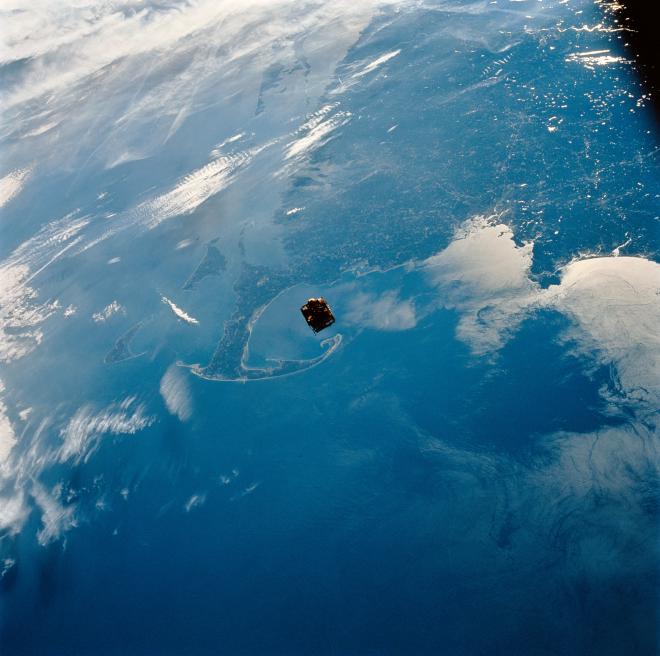
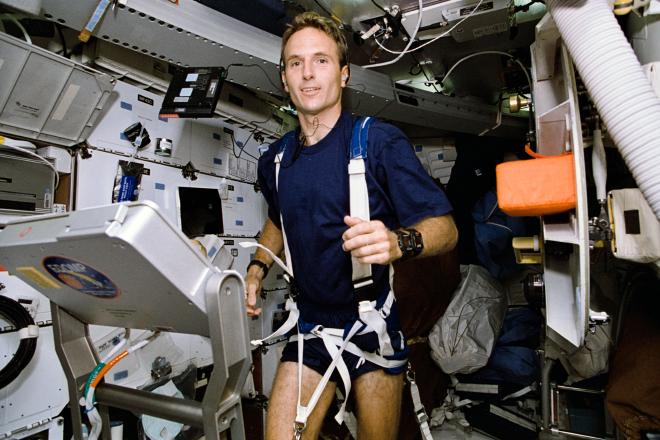
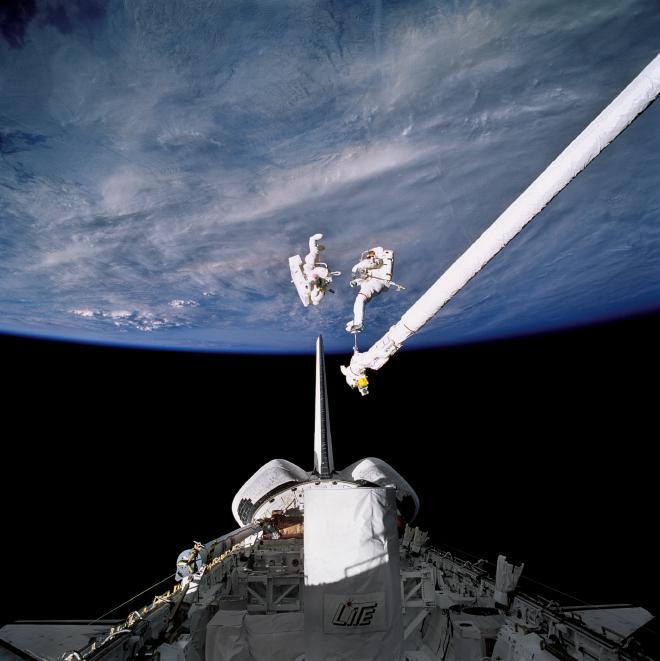
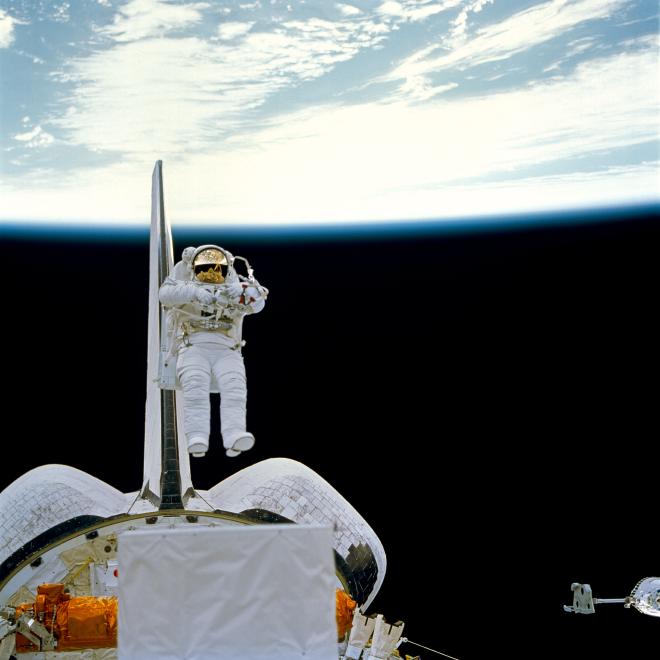
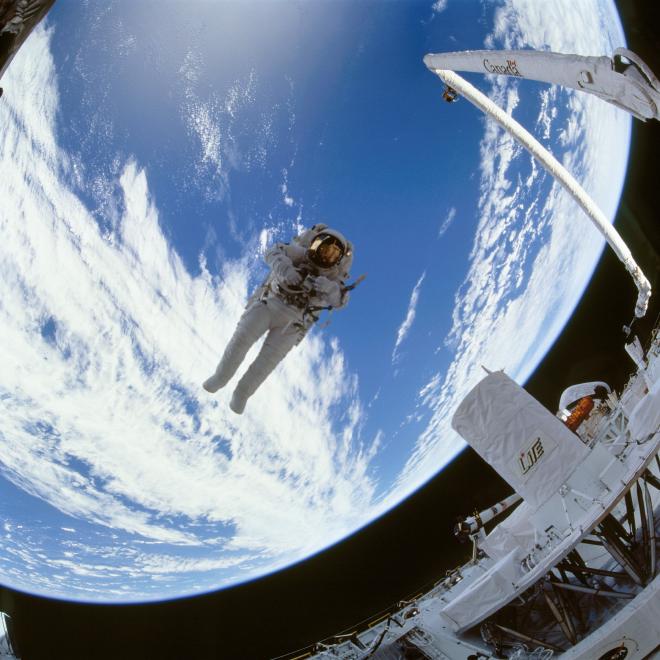
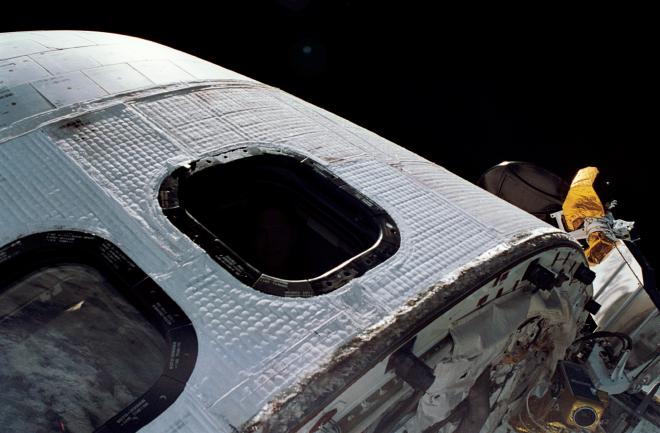
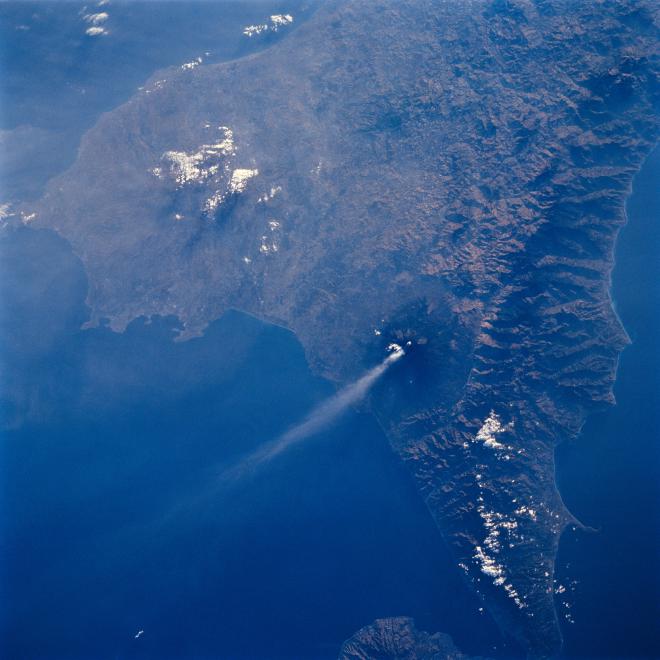
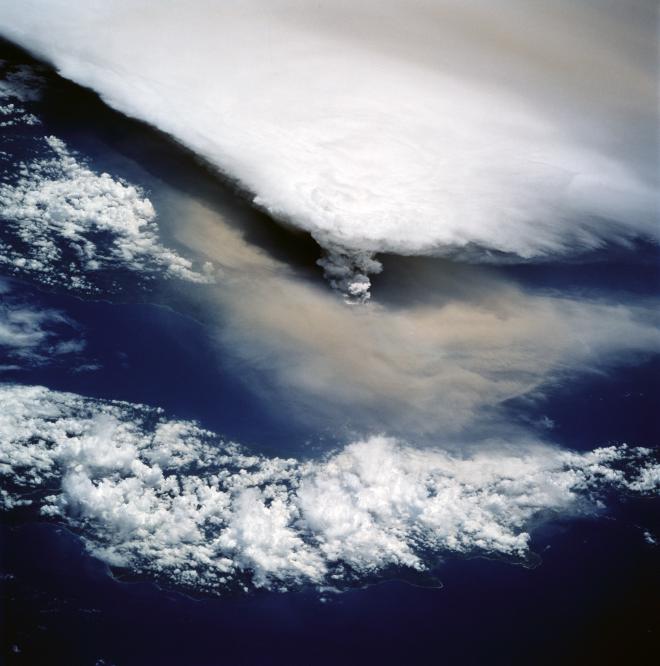
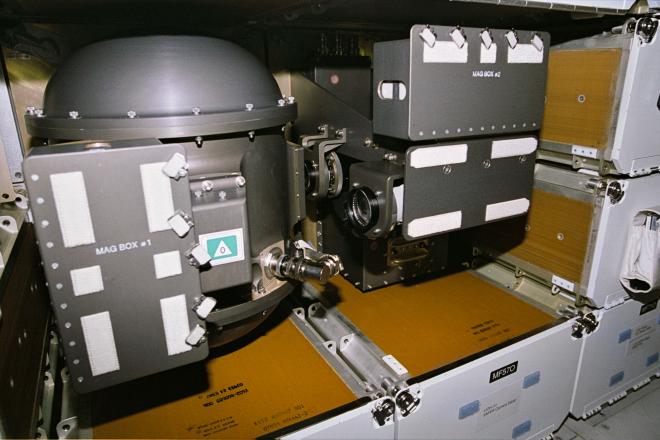
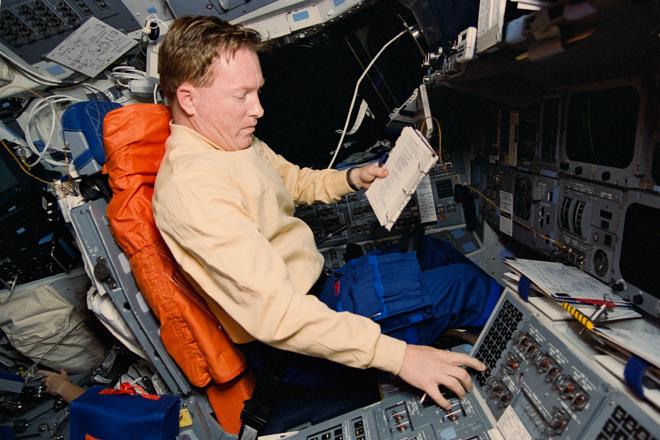
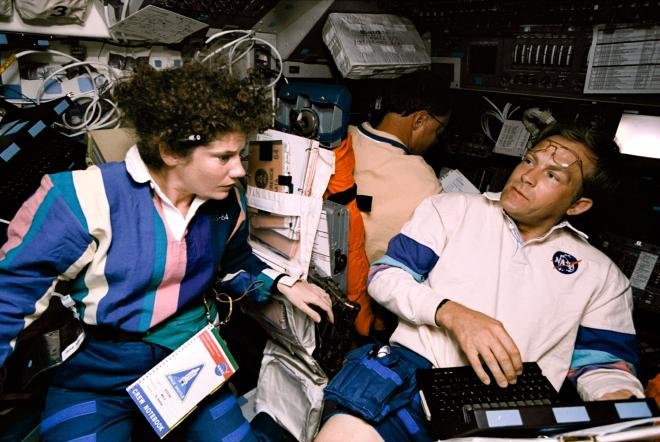
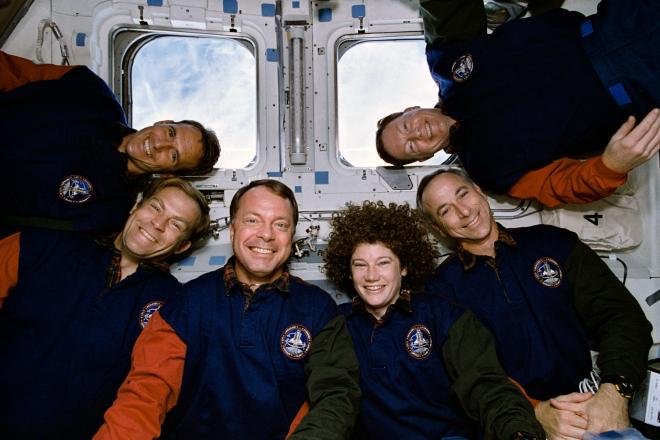
For more photos, head over to our friends at Wikiarchives.space: https://wikiarchives.space/index.php?/category/859
Post-Flight Presentation #
If you’d like to see the mission in motion you can check out the post-flight presentation here:
Mission Highlights Resource Tape #
Ever wanted to watch an hour of B-roll from STS-64? Well now’s your chance!
Transcript #
NOTE: This transcript was made by me just copying and pasting the script that I read to make the podcast. I often tweak the phrasing on the fly and then forget to update the script, so this is not guaranteed to align perfectly with the episode audio, but it should be pretty close. Also, since these are really only intended to be read by myself, I might use some funky punctuation to help remind myself how I want a sentence to flow, so don’t look to these as a grammar reference. If you notice any egregious transcription errors or notes to myself that I neglected to remove, feel free to let me know and I’ll fix it.
Hello, and welcome to The Space Above Us. Episode 138, Space Shuttle Flight 64, STS-64: Ghostbusters and Angry Russians
Last time, we expanded the long duration envelope for the space shuttle on STS-65. Between BioRACK, BioSTACK, TEMPUS, PAWS, and all the others, we generated a massive amount of scientific data. We also bid farewell to the Lower Body Negative Pressure device, while welcoming IML-man to the stage.
Much like STS-65, on STS-64 we won’t have one big central payload that the whole mission revolves around. Instead, we’re going go have a grab-bag of just about everything the shuttle program has to offer. Middeck science, getaway specials, technology demonstrations, EVAs, rendezvous.. you name it, we got it. In fact, let’s do better than name it and let’s just get right into the mission.
Commanding the flight was someone we’ve known since STS-28: Dick Richards. When we last saw Richards, he was executing Columbia’s first ever landing at the Kennedy Space Center after a successful flight of the US Microgravity Laboratory on STS-50. Knowing that this would be his fourth and final flight, he had asked for a rendezvous flight, and with STS-64 he got his wish.
Joining Richards up front was Blaine Hammond, our Pilot for today’s mission. We last saw Hammond as pilot of STS-39, which carried a number of unclassified Department of Defense experiments. This is his second and final flight.
Moving on to the mission specialists, we meet Mission Specialist 1, and our lone rookie for today’s flight, Jerry Linenger. Jerry Linenger was born on January 16th, 1955 and grew up in Eastpointe, Michigan. Linenger is no stranger to a classroom, holding a bachelor’s degree in bioscience, a doctorate in medicine, a master’s in systems management, a master’s in health policy, and a PhD in epidemiology. With the US Navy, he served as a flight surgeon, medical advisor, and research principal investigator. He was selected as an astronaut in 1992 and with this flight becomes the first of his class to fly. He was actually a late addition to the crew, announced several months after everyone else. Not to diminish Jerry’s clearly impressive record, but the primary reason for his inclusion on this flight was that Linenger was preparing for a stint on the Russian space station Mir, and the Russians insisted that all NASA astronauts staying on Mir must have prior spaceflight experience. Well, let’s get him some spaceflight experience! This is Linenger’s first of two flights.
Sitting in the middle of the flight deck was Mission Specialist 2, Susan Helms, flying for the second time. When we last saw her, Helms was helping to deploy TDRS-F on STS-54. Today, among other tasks, she’ll conduct extensive RMS operations as part of the SPIFEX payload. This is her second of five flights.
Mission Specialist 3 was Carl Meade, who we last saw flying on STS-50 with Dick Richards. Among other things, he’ll make up half of the EVA team and both deploy and capture SPARTAN on this, his third and final flight.
Joining Meade outside will be Mission Specialist 4 and Payload Commander, Mark Lee. When we last saw Lee he was getting science done on STS-47, the Japanese Spacelab mission. This is his third of four flights.
When launch day arrived, the crew didn’t encounter any dreaded scrubs, but encountered something maybe even worse: an extended delay. As we’ve learned, while we certainly shouldn’t feel too bad for the crew, given where they’re going next, waiting on the pad is not the most comfortable experience. They have to lie on their backs, resting on top of a parachute and oxygen bottles, staring either straight up at the sky, or just at some middeck lockers. And while technically, accommodations were made to allow them to relieve themselves, it wasn’t something that most astronauts were eager to try. So it must have been a bummer when weather delays held Space Shuttle Discovery firmly in place for nearly two hours.
For Mission Specialists 1 and 3, Linenger and Meade, it was maybe slightly better. That’s because for this flight, they would be the first astronauts to fly with the new Advanced Crew Escape Suits. As you’ll recall, after the Challenger accident, it was decided that crews should fly in pressurized suits during launch and entry. Chances were somewhat slim that they would actually save the crew, but I think after the psychological trauma that everyone experienced with STS-51L, it was worth the discomfort and expense to at least give the crews a fighting chance. That fighting chance came in the form of the Launch and Entry Suit, derived from protective suits worn by high altitude Air Force pilots. Formerly known as the S1032, in an emergency, the suit should provide the crew with precious moments to recover the spacecraft, or under some circumstances, bail out to a parachute landing.
The Launch and Entry Suits did the job, but as we heard from Rhea Seddon, they weren’t the most comfortable garments to put on or wear. They also weren’t full pressure suits, but rather partial pressure suits, which I believe are more appropriate for brief emergencies, not lengthy stays in an unpressurized spacecraft.
With this flight, we meet S1035, the Advanced Crew Escape Suit, or ACES. In his history of spacesuits titled Dressed for Altitude, shuttle historian Dennis Jenkins notes that compared to the LES, ACES was lighter, less bulky, cooler, and more comfortable. The suit also was a fully pressurized suit, providing better protection to the crews. Visually, the LES and ACES are almost indistinguishable, but if you look closely you can notice a few differences. Perhaps the most visible difference between the LES and ACES was the addition of metal wrist rings where the crew could remove gloves while staying in the suit. That way they could stay mostly suited but still maintain unimpeded use of their hands until the last minute. And even when they did don the gloves, they would find them more comfortable and with better grips, which I’m sure was appreciated by the pilot crew.
I’m not entirely sure why they didn’t just switch entirely from one suit to the other, but starting with this flight we’re going to see a mix of Launch and Entry suits and Advanced Crew Escape Suits all the way up until STS-102 and onward, when only ACES will be flown.
So hopefully Linenger and Meade were having a comfortable time as they, and the rest of the STS-64 crew, sat through an hour and 52 minutes of weather-related delays. Eventually the weather cleared up, and on September 9th, 1994, at 6:22 PM Eastern Time, Space Shuttle Discovery once again tore through the Florida skies on its way to orbit.
Shortly after arriving in its 57 degree, 260 kilometer high orbit, Discovery’s payload bay doors were opened and the crew got to work. If you were to somehow fly alongside Discovery and watch, you’d see something that will become very familiar in shuttle missions far down the road. The remote manipulator system was uncradled, moved over to the starboard side of the payload bay, and grappled a long extension carrying extra instrumentation. No, this wasn’t the Orbiter Boom and Sensor System we’ll see from 2005 onward, it was the Shuttle Plume Impingement Flight Experiment, or SPIFEX.
Much like Mission Specialist Linenger, SPIFEX was flying on this mission as part of preparations for the Shuttle-Mir program. As we’ve established, the space shuttle orbiter was, somewhat amazingly, not really designed with rendezvous in mind. The placement of its thrusters were more concerned with stuff like control authority during entry than what sort of local environment they might create in space. This has caused us trouble all the way from the earliest rendezvous missions since ideally, when approaching a delicate spacecraft, the shuttle should not blast the heck out of it with its gigantic reaction control system thrusters. Using a combination of clever rendezvous approaches and some tricks with operating the thrusters, such as the low-Z mode, this problem had largely been solved, even allowing rendezvous with especially sensitive targets like the Hubble Space Telescope or Long Duration Exposure Facility.
But even with those assurances, Russia was a little concerned. If you load up a photo of Mir, you can hardly blame them. It looks like a stiff breeze could scatter that thing into a million pieces. What was going to happen when this big noisy spaceplane came sidling up next to the Russian space station, firing off massive plumes from its mighty RCS thrusters? Well, SPIFEX was going to find out.
The experiment consisted of a ten meter long boom extension, actually made from spare parts for the main robot arm, as well as sensors that would measure the impact of the plumes. In two sessions both early in the mission and about a week later, SPIFEX was precisely moved through 60 different locations around the orbiter while 86 RCS test firings were performed. This work would help to characterize the geometry of the thruster plumes and what sort of force was imparted at which ranges. Armed with this information, it would be possible to craft an approach to Mir that would not put undue stress on the various solar arrays, antennas, and other appendages attached to the station’s exterior, hopefully easing the concerns of our Russian partners.
Something that also will be keeping a close eye on those thruster plumes is our next payload: SPARTAN. We’ve seen this Goddard experiment a few times now, and it’s a pretty nifty device, even with its eye-rolling acronym: Shuttle Point Autonomous Research Tool for Astronomy. SPARTAN, again, is that boxy payload about the size of a large refrigerator, covered in gold foil. By taking advantage of the space shuttle’s capabilities, SPARTAN was kind of a best of both worlds spacecraft. It required the shuttle to both drop it off and pick it up, but that also meant that it could be vastly simpler than a dedicated spacecraft, while still having the benefits of operating as a free-flying satellite, away from the noisy environment of the orbiter. Once unberthed and ungrappled by Mission Specialist Carl Meade, the tiny spacecraft did a little pirouette to demonstrate that it was operating properly and that its attitude control system was working. I guess in the absence of a communication system, satellites take a page out of the bees’ book and communicate via dance!
As a top level summary, SPARTAN worked flawlessly, spending nearly two days flying on its own and taking measurements of the sun’s corona and ultraviolet output that are difficult or impossible from the ground. Digging in a little deeper, there were two minor issues during deployment. First, the Ku-band antenna, which has double duty as a high throughput communications link as well as a rendezvous radar, failed to lock on to SPARTAN as Discovery slowly moved away. The crew put the radar through various different search modes and power levels, hoping to encourage a lock-on, but for almost an hour, it had no luck. In the end this was more of an annoyance than a serious problem, just leading to a tweak of the later rendezvous profile, but would surely lead to a lengthy investigation for the team responsible for the antenna. Just because it wasn’t a serious problem this time doesn’t mean it won’t be next time. It also sent the flight dynamics team scrambling to develop a procedure to use in case the radar failed again when it came time to pick SPARTAN up, but thankfully that was not the case.
Simpler to solve was the mystery of why the camera mounted in the bottom of the payload bay failed to operate during the SPARTAN unberthing. Later investigation revealed that the labels for the payload-specific buttons had been scrambled a bit. So when they pressed the button with the right label, nothing happened. Had the crew pressed the “video tape recorder” button instead, they would have activated the camera. Whoops.
While SPARTAN gathers science on its own, we have some science data to collect back on the orbiter. But before we get into the second primary science payload for this mission, I think we have time to enjoy a quote from Mission Specialist Linenger, recalling his time on STS-64. He said that Commander Dick Richards took the science on this flight seriously and even signed up to do some experiments himself, but he also had some fun with it. As Linenger tells it, quote “Whenever he’d go to the head, whether during training or up in space, he would come out holding his urine sample up to the heavens, and yell out “Science!” as if praising the god of science. During the shuttle flight, I’d wake up in the middle of the night and hear someone yelling “Science!!” in the background. It was Dick Richards keeping us in stitches.”
Haha, gotta keep crew morale up.
But for our next experiment we’re going to be heading considerably further aft of the waste collection system and into the payload bay, where we’ll meet the Lidar In-Space Technology Experiment, or LITE. LITE was the latest in a long line of shuttle experiments that are gathering useful data but are primarily flying as a technology demonstration. With the shuttle available as a stable platform that can provide power, attitude control, the desired orbit, and all that other good stuff, engineers could focus on the crux of a potential upcoming mission and see what stumbling blocks might exist. Then they can take those lessons learned and get it right the first time when they build a dedicated spacecraft for the instrument in question.
The instrument in question this time, was LITE, which is great for me making an audio-only story since there’s no way for me to distinguish between light (L-I-G-H-T), the electromagnetic waves we all know and love and LITE (L-I-T-E), the experiment currently residing in Discovery’s payload bay. Oh well. Just like it says on the box, LITE a lidar. As you may have guessed, lidar is pretty much the same thing as radar, but instead of sending out radio waves, it’s sending out light waves. Now, technically, radio waves and light waves are the same thing, but this light has a much higher frequency and is also a special type of uniform light called a laser. With a laser, all the photons being emitted share the same wavelength and are all lined up. This is why when you turn a flashlight on, you get a big blob of light, but if you turn a laser pointer on, you get a small dot that you can use to antagonize cats.
With LITE, NASA was trying out a potentially useful new tool for an earth observation satellite. As we’ve discussed in the synthetic aperture radar episodes, most observation satellites are passive. They collect light that’s bouncing off the planet and either make photos or spectrograms or whatever their mission calls for. With synthetic aperture radar, we sent out our own radar pulse and watched to see how it was changed by interacting with the Earth. Well, on LITE, we’re basically going to do the same thing, but with a laser. A critical difference here is that a laser is so tightly focused that by the time it got to the surface, the beam would only be about 300 meters across. That’s still the size of several football fields, but in the context of an experiment 260 kilometers up, that’s pretty great. The result will be extremely high resolution maps of stuff in the atmosphere: dust, water droplets, probably a couple of confused birds, stuff like that. Among more typical atmospheric samples, Discovery also flew over Super-Typhoon Melissa, peeling back the curtains of rain and giving researchers fascinating new views of the structure of these massive storms.
In principle, the operation was pretty simple, though I’m sure in reality a lot of blood, sweat, and tears went into making it all work as well as it did. First, LITE would send out a pulse of light in one of three frequencies: one frequency was UV, one was infrared, and one was visible. Green, if you’re curious. Ten pulses would be sent out every second, which already sounds pretty fast, but it turns out that each pulse lasted for only 30 nanoseconds. Thanks to Hubble we’ve developed little bit of intuition for just how small anything with the prefix ‘nano’ on the front really is, but this fun fact sort of blew me away.. with the laser traveling away from the orbiter at the speed of light, and with the pulse lasting only 30 nanoseconds, the front of the pulse was only nine meters away from Discovery by the time the pulse was ended. To make that a little more concrete, the leading edge of the pulse would be somewhere near the top of the orbiter’s tail. So this nine meter long slug of light was fired out, traveled through a bunch of dust and rain, and birds (well, probably not through the birds), and reflected back, and was collected by a one meter wide telescope situated right next to the laser. And if you’re a fiscally-minded taxpayer wondering how much this one meter wide specialized telescope cost, don’t worry, NASA’s got your back. It’s actually a refurbished engineering model from the 1960s Orbiting Astronomical Observatory, saving the space agency a cool six million bucks.
If you’re anything like me, you’re probably thinking about that visible wavelength laser, and wondering if it would have been possible to see it from the ground. I don’t actually know, but I did have a raised eyebrow moment when I saw that in the press kit, NASA noted that while the laser was harmless at normal magnifications, anybody using a telescope with a mirror wider than six inches ought to take care when observing the orbiter or they might damage their eyes. I think I’m good without the telescope, thanks.
Over the course of the mission, LITE collected data through 53 hours of operation, exceeding the pre-mission goals by 15%. Quoting right from the official mission report, scientists acquired unprecedented views of cloud structures, storm systems, dust clouds, pollutants, forest burning, and surface reflectance. I didn’t do the legwork to make a hard connection here, but I will say that the goal of this payload was to serve as a technology demonstration mission for a potential lidar-based spacecraft to be added to the earth observing system.. and these days you can find a lidar-based spacecraft flying in the earth observing system that goes by the name of Cloud-Aerosol Lidar and Infrared Pathfinder Satellite Observations or CALIPSO. So I suspect CALIPSO may owe STS-64 a debt of gratitude.
Yet another sign of the imminent Shuttle-Mir program was the flight’s lone spacewalk, featuring mission specialists Mark Lee and Carl Meade heading outside, and Jerry Linenger serving as the intravehicular crewmember. We’ve done quite a few EVAs from the space shuttle at this point, and they all had something in common. If by some unlikely series of events, an EV crew member found themselves detached from the orbiter, drifting away into space, the pilot crew would have no problem blipping the thrusters a few times to go chase them down. We’ve even seen this for dropped tools. The reason that this was possible was because the orbiter was just on its own. Even when it had grappled or berthed a payload, it still had a fair amount of freedom. But when the shuttle started docking with space stations, the situation would be different.
You can’t just undock from a station and go flying away from it at the drop of a hat. Hatches need to be sealed, pressures equalized, and trajectories need to be carefully assessed. Then, you might even have to carefully steer around the station to get to your stranded crew member. Clearly, becoming disconnected from the spacecraft while the shuttle is docked to a station was a major problem. So what to do? Ahh, I bet you’re thinking what I’m thinking. “Yes! It’s finally time to bring back the Manned Maneuvering Unit!” After all, if Pinky Nelson can fly out to poke at Solar Max, it should do a great job recovering someone who’s drifted off into space. Well, sure, yeah. It would. But that seems like a whole lot of added bulk, mass, and expense to protect against something that we don’t actually expect to ever happen. But there might be something to that. We need some sort of smaller jetpack that will make EVAs around space stations safer.. hmm.. safer.. oh! I know! How about the Simplified Aid for Extravehicular Activity Rescue. We’ll call it SAFER for short.
I love SAFER. This nifty little 30 kilogram device was sort of scrumbled together out of spare parts, solving a serious problem quickly, cheaply, and of course, safely. In essence, it’s a smaller version of the Manned Maneuvering Unit. But rather than being a gigantic backpack that almost enveloped the astronaut, this was a smallish box that just sort of snapped onto the bottom of their life support pack. It even used the same connections as the MMU. Inside that box were 24 thrusters that would expel harmless nitrogen gas, allowing a stranded astronaut to halt a disorienting tumble, point back to the structure, and putter on back. SAFER provided about three meters per second of delta-v, meaning that an EVA crew member could only change their speed by three meters per second, or 6.7 miles per hour. That doesn’t sound like a lot, but in expert hands, it was more than enough to get back on structure. In fact, if an astronaut were feeling particularly bold, and stupid, they could easily fly over a kilometer away and back with that amount of delta-v.
I say SAFER was scrumbled together because it seems to have just been built out of what was already lying around. OK, that’s an overstatement, but it’s not that far off. SAFER was built out of off the shelf hardware, pre-qualified spare MMU components, an old Apollo translational hand controller, and I think it was powered by just like, normal nine-volt batteries. Part of what kept it so simple and cheap is that it was never intended for normal operations, allowing it to get away without a lot of redundancy. It was a safety net. Yeah, of course you want to put effort into making sure that your safety net is dependable, but you don’t need a safety net for your safety net.
OK great, so we have this new device, and Mark Lee and Carl Meade are going to try it out. But what makes this spacewalk notable was that they were going to test SAFER.. without a tether. That’s right, for the first time since STS-51A, ten years ago, we’re going to have crew members outside, flying around completely untethered. Why? Well, after much deliberation, it was actually determined that this was the safest way to test SAFER. An important part of the test was proving that an astronaut could recover from a spin. Doing that while tethered was just a recipe for getting all wrapped up in the tether. So instead, the safest thing would be to carefully plan ahead, don’t get going too fast or too far, and be ready to react if something went wrong.
While mission commander Richards allowed this experiment on his flight, he clearly wasn’t wild about it. In an oral history interview he said he was, quote “nervous as hell” about the experiment. Given that the device didn’t have redundancy, the crew established very conservative ground rules. And the entire time it was being used, Richards was watching the EV crew like a hawk, ready to jump on the shuttle controls at a moment’s notice.
And Richards wasn’t the only one who was blown away by the nature of this daring EVA. Jerry Linenger later said quote “The one thing I’ll always picture from STS-64 is watching Carl Meade and Mark Lee out there testing the new jetpacks, spinning on the end of the arm, totally free of the shuttle and the Earth below them. It’s one of those pictures that’s pretty much imprinted in my brain, even though I wasn’t doing the spacewalk. Every astronaut knows that is one special operation - being an independent spacecraft, out there floating free.”
So what did they actually do out there? They basically just took SAFER for a test spin. Staying within an imaginary box in the payload bay, they tried gaining speed, coasting, and braking. They tried rotating around. They tried recharging the device with a fresh load of nitrogen. And the crew members took turns gently spinning each other to see if the other could get out of the spin. Considering that these spins were just being imparted by hand, it isn’t too surprising that one got going a little faster than planned. Instead of rotating at a maximum of 30 degrees per second, Mark Lee got spun up to 40 degrees per second. That doesn’t sound like too huge a difference but if you think about it, it’s 33% faster than the fastest planned rotation. I don’t know if Dick Richards’ hand jumped to the control stick, but it turns out he had nothing to worry about, because Lee simply flipped the attitude hold mode, SAFER did its thing, and he was soon stable again, no problem.
With this 6 hour and 51 minute long EVA, Mark Lee and Carl Meade became the 7th and 8th people to perform tetherless EVAs.. and the last of the entire shuttle program. Well, I guess 19th and 20th people if you want to call the Apollo surface EVAs “untethered EVAs”, but you know what I mean. Thankfully, while SAFER was ready to jump in when needed, the nifty little backpack was never required on any shuttle flight. Though I will say that the system is still in use on the International Space Station today, so you never know.
The EVA itself went as smooth as silk, but a minor operational hiccup afterward almost spiraled into a major problem. Instead, it becomes a hilarious story out of the oral histories. As recounted by mission commander Dick Richards, Lee and Meade had some difficulty getting out of the airlock due to some unspecified equipment problem. This meant that both Jerry Linenger and Susan Helms, who had been helping with the EVA from the aft flight deck, headed down to the middeck to help out. That left Richards alone on the flight deck to wrap things up. One of the post-EVA tasks is to dump wastewater from the suits into the orbiter’s wastewater tank. To do this, the water collection system, aka space toilet, was reconfigured to accept the fluid from the space suits. Richards dutifully flipped the proper switches to ensure that the valves were in the desired configuration.. but forgot a step. Part of the task was to put up some sort of little sign to warn crew members not to use the system at the moment since it was in use by the extravehicular mobility units.
Mark Lee finally got out of his suit and headed up to relieve himself with the waste collection system. He noticed that the valves are in the wrong configuration but didn’t see the little sign that explains why, since Richards forgot to set it up. Lee flipped the switches back to the proper configuration so he could use the facility, and then got back to work.
Cut to 45 minutes later, and Susan Helms opens the curtain to the waste collection system and calls out “ahhh!!!” Everyone turns and sees a big giant ball of fluid hanging off the end of the urinal hose. When Lee went to use the WCS, he had reset the valves, preventing the suit water from getting into the wastewater tank. Instead, it just accumulated in the hose and eventually collected in a huge ball of fluid just hanging there.
The ball of fluid was so big that there weren’t enough towels, or even spare clothes on board to soak the whole thing up. And as Richards pointed out, they were one RCS jet firing away from the whole thing splattering all over the place. Now, the WCS deals with fluid on the end of the urinal hose all the time, after all that’s the whole point of it. Little fans move the air and pull the fluid down the hose. But the little fans weren’t supposed to be used on something big like this. Faced with no alternative, Richards said “OK guys, hold your breath” and activated the fans. Right before their eyes the ball got smaller and smaller until quote “finally it just disappeared like a little ghost or something you see in Ghostbusters where they vacuum up ghosts”. The fans held up without any trouble, but after the mission, during the debrief, Richards asked the mission controllers if they noticed anything odd. They said they did notice some currents that they couldn’t understand but since everything quickly went back to normal, they didn’t ask.
STS-64 ended up being a little longer than anyone expected. Partway through the flight, when it became clear that the orbiter’s limited onboard resources were being used at a reasonable rate, an extra day was tacked onto the flight. And then when it came time to head home, our old friend the Florida weather reared its head again, and both attempts at landing at Kennedy were waved off, leaving Discovery on orbit for another day. The next day they got ready to do it all over again, and were once again waved off twice, forcing them to eventually turn their sights to Edwards Air Force Base. But thanks to these four deorbit attempts, we get another great story from the oral histories.
Due to the high inclination orbit flown by this mission, the crew would frequently find themselves passing over a particular location in Russia. This location was apparently an old Soviet ground station, and whenever Discovery flew over head, the Russians working at the ground station would light the orbiter up, radiating them with electrical energy. This was pretty annoying because it disrupted radio communications back to Houston. It was so dependable, that mission control would warn the crew when the ground station was coming up so they could prepare for a few minutes of dropped signal.
What were the Russians doing? Who knows. My guess is they were using radar to track the orbiter, but maybe using a little more power than necessary, knowing that they’d irritate the crew. I doubt they realized that in addition to disrupting communications, their actions also caused a loud and annoying noise to be played over the crew’s headsets. After a couple of times of this, something occurred to Dick Richards. He turned to his pilot, Blaine Hammond, and asked, “Blaine, you speak Russian don’t you?” Hammond had been learning Russian in the hopes of getting a stint on Mir, so he responded “Yeah.” Richards said “Why don’t you just reconfigure the headset and just tell those guys to get the hell off our frequency.” Helms chimes in “Yeah, Blaine, tell them” and soon the rest of the crew is saying “Yeah, Blaine, tell them!”
Well alright then! Hammond switches the comms over to UHF, which, as I recently learned when getting my amateur radio license, won’t reflect off the atmosphere, so is just for line of sight communications. That meant that only people directly under the orbiter would be able to hear them. Hammond says something in Russian, later explaining “All I did was very nicely tell them this is the Space Shuttle Discovery and would you please not use this frequency as we’re conducting critical operations.” The next thing they knew, the Russian ground station had cranked their system to full power, while Russian voices got on and started yelling at them. The radio bombardment was so loud that they had to give up and turn off UHF completely. Once it was silent, someone asked “What the hell did you say, Blaine?” and the entire crew cracked up.
After four attempts at landing in Florida, Space Shuttle Discovery touched down at the Edwards Air Force Base after an uneventful reentry, closing out OV-103’s 19th mission. Thanks to the extra two days on orbit, STS-64 clocks in at 10 days, 22 hours, 49 minutes, and 57 seconds. For those keeping track at home, Discovery has now racked up almost 129 days in space.
I think with this mission it’s increasingly clear that we are rapidly approaching the Shuttle-Mir flights, with the first docking only five missions down the road. Good science is still getting done, with LITE, SPARTAN, and a number of getaway specials and small middeck experiments that I didn’t get into, but between Linenger’s late inclusion, the SAFER demo, and even Blaine Hammond’s adventures with the Russian language, it’s clear that NASA is pivoting to focus towards this precursor to the International Space Station. Let’s just hope that they don’t have UHF on Mir.
Next time, Endeavour’s back on the launchpad after successfully carrying the Space Radar Laboratory on STS-59. Let’s just take a peek and see what it’s carrying in its payload bay this time.. wait.. the Space Radar Laboratory again? And.. and is that Tom Jones back on the middeck?? Deja vu!
Ad Astra, catch you on the next pass.
